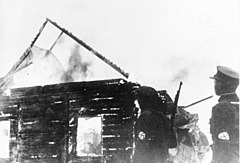
Back الهولوكوست في ليتوانيا Arabic Litvada holokost Azerbaijani Holokaust u Litvaniji BS Holocaust a Lituània Catalan Holocaust in Litauen German Holocausto en Lituania Spanish Holokaust Leedus Estonian هولوکاست در لیتوانی Persian Shoah en Lituanie French שואת יהודי ליטא HE
You can help expand this article with text translated from the corresponding article in Norwegian. (December 2023) Click [show] for important translation instructions.
|
 Burning synagogue in Lithuania. | |
| Date | June–December 1941 |
|---|---|
| Target | Jews |
| Organised by | Einsatzgruppen, Ypatingasis būrys |
| Deaths | 190,000–195,000 |
The Holocaust in Lithuania resulted in the near total eradication of Lithuanian (Litvaks) and Polish Jews[a] in Generalbezirk Litauen of the Reichskommissariat Ostland in the Nazi-controlled Lithuania. Of approximately 208,000–210,000 Jews at the time of the Nazi invasion, an estimated 190,000 to 195,000 were killed before the end of World War II, most of them between June and December 1941. More than 95% of Lithuania's Jewish population was murdered over the three-year German occupation,[1] a more complete destruction than befell any other country in the Holocaust.[2] Historians attribute this to the massive collaboration in the genocide by the non-Jewish local paramilitaries, though the reasons for this collaboration are still debated.[3] The Holocaust resulted in the largest loss of life in so short a period of time in the history of Lithuania.[4]
The events in the western regions of the USSR occupied by Nazi Germany in the first weeks after the German invasion, including Lithuania, marked a sharp intensification of the Holocaust.[5][6][b]
The occupying Nazi German administration fanned antisemitism by blaming the Soviet regime's annexation of Lithuania in June 1940, on the Jewish community. One prevalent antisemitic trope at the time linked Bolsheviks and Jews.[7] There were other tropes, even more unpleasant. To a large extent the Nazis also relied on the physical preparation and execution of their orders by local Lithuanian collaborators.[3]
As of 2020, the topic of the Holocaust in Lithuania and the role played by Lithuanians in the genocide, including several notable Lithuanian nationalists, remained unsettled.[8]
- ^ Porat, Dina (2002). "The Holocaust in Lithuania: Some Unique Aspects". In David Cesarani (ed.). The Final Solution: Origins and Implementation. Routledge. pp. 161–162. ISBN 978-0-415-15232-7.
- ^ Reich, Aaron (23 September 2021). "On This Day: Nazis liquidate Vilnius Ghetto, slaughter Lithuanian Jews". The Jerusalem Post | JPost.com. Retrieved 2023-08-19.
- ^ a b MacQueen, Michael (1998). "The Context of Mass Destruction: Agents and Prerequisites of the Holocaust in Lithuania". Holocaust and Genocide Studies. 12 (1): 27–48. doi:10.1093/hgs/12.1.27. ISSN 8756-6583.
- ^ Bubnys, Arūnas (2004). "Holocaust in Lithuania: An Outline of the Major Stages and Their Results". The Vanished World of Lithuanian Jews. Rodopi. pp. 218–219. ISBN 978-90-420-0850-2.
- ^ Matthäus, Jürgen (2007). "Operation Barbarossa and the onset of the Holocaust". In Christopher R. Browning (ed.). The Origins of the Final Solution: The Evolution of Nazi Jewish Policy, September 1939–March 1942. University of Nebraska Press. pp. 244–294. ISBN 978-0-8032-5979-9.
- ^ Porat, Dina (2002). "The Holocaust in Lithuania: Some Unique Aspects". In David Cesarani (ed.). The Final Solution: Origins and Implementation. Routledge. p. 159. ISBN 978-0-415-15232-7.
- ^ Kwiet, Konrad (1998). "Rehearsing for Murder: The Beginning of the Final Solution in Lithuania in June 1941". Holocaust and Genocide Studies. 1 (12): 3–26. doi:10.1093/hgs/12.1.3. ISSN 8756-6583.
- ^ Stanislovas Stasiulis (2020). "The Holocaust in Lithuania: The Key Characteristics of Its History, and the Key Issues in Historiography and Cultural Memory". East European Politics and Societies. 34 (1): 261–279. doi:10.1177/0888325419844820. Retrieved January 4, 2024.
© MMXXIII Rich X Search. We shall prevail. All rights reserved. Rich X Search